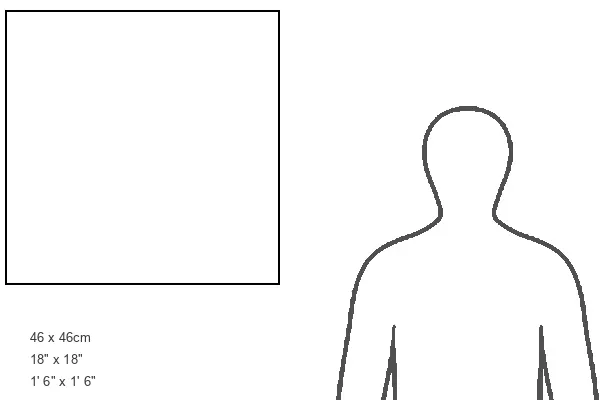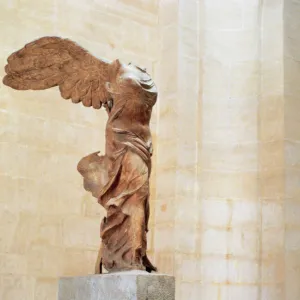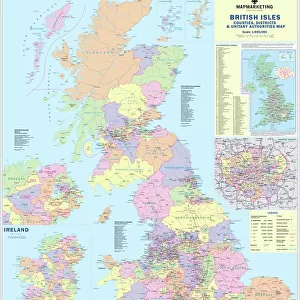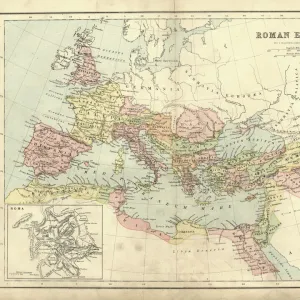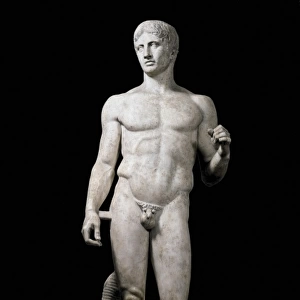Pillow > Historic > Ancient civilizations > Roman Empire > Roman sculptures
Pillow : Portrait Bust of an Aristocratic Man and Portrait Bust of an Aristocratic Woman, c
![]()

Home Decor From Fine Art Finder
Portrait Bust of an Aristocratic Man and Portrait Bust of an Aristocratic Woman, c
499618 Portrait Bust of an Aristocratic Man and Portrait Bust of an Aristocratic Woman, c.270-280 (marble)
by Roman Imperial Period (27 BC-476 AD); 35.2x21.5x12 wt:15.5 lbs (man) cm; Cleveland Museum of Art, OH, USA; (add.info.: These busts are thought to have been unearthed with the Good Shepherd and Jonah sculptures displayed nearby. The nearly identical facial characteristics of each sitter-three males and three females-suggest that the same man and woman was represented three times. Although the intended function of the busts remains unknown, they probably represent a husband and wife. The portraits have been dated stylistically, as well as by costume and hairstyle, to the 270s ad. One of the men wears a paludamentum, or fringed cloak. One of the women wears a decorative stole, an attribute of rank probably conferred on her by her husband. The most distinctive feature of the female portraits is the hairstyle, a variation of the scheitzelkopf, in which the hair, after being combed behind the ears down to the nape of the neck, is braided, pulled up over the top of the head and folded under at the front. Careful study of the evolution of womens coiffures supports a date of 270 to 280 ad for the portraits, about the same as the symbolic sculptures of Jonah and the Good Shepherd.
The rarity of intentionally paired portrait busts in late antiquity, especially those in a series, raises questions as to their original function. The busts may have been commemorative and intended for distribution as diplomatic gifts. It is likely that they were commissioned by a single, important patron or family to enhance their social or political status.
); John L. Severance Fund; out of copyright
Media ID 23179938
© John L. Severance Fund / Bridgeman Images
18"x18" (46x46cm) Pillow
18"x18" (46x46cm) Faux Suede Pillow with a plush soft feel. Your choice of image fills the front, with a stone colored faux suede back. Flat sewn concealed white zip.
Accessorise your space with decorative, soft pillows
Estimated Product Size is 45.7cm x 45.7cm (18" x 18")
These are individually made so all sizes are approximate
Artwork printed orientated as per the preview above, with landscape (horizontal) or portrait (vertical) orientation to match the source image.
FEATURES IN THESE COLLECTIONS
> Arts
> Artists
> R
> Roman Roman
> Europe
> United Kingdom
> England
> Cleveland
> Historic
> Ancient civilizations
> Roman Empire
> Roman art
> Historic
> Ancient civilizations
> Roman Empire
> Roman sculptures
EDITORS COMMENTS
This print captures the exquisite "Portrait Bust of an Aristocratic Man and Portrait Bust of an Aristocratic Woman" from the Roman Imperial Period. These marble busts, measuring 35.2x21.5x12 cm and weighing 15.5 lbs (man), are currently housed in the Cleveland Museum of Art in Ohio, USA. Believed to have been unearthed alongside sculptures depicting the Good Shepherd and Jonah, these busts share strikingly similar facial features among three male and three female sitters. It is highly likely that they represent a husband and wife, although their intended function remains unknown. Stylistically dated to the 270s AD through careful analysis of costume, hairstyle, and other attributes, these portraits offer a glimpse into ancient fashion trends. Notably, one man wears a paludamentum cloak while one woman adorns a decorative stole bestowed upon her by her husband as a symbol of rank. The most distinctive feature of the female portraits is their unique hairstyle known as scheitzelkopf – hair braided behind the ears down to the nape of the neck before being folded under at the front. This particular coiffure further supports dating these portraits to around 270-280 AD. The rarity of intentionally paired portrait busts during late antiquity raises questions about their original purpose. They may have served as commemorative pieces or diplomatic gifts for distribution among influential individuals or families seeking to enhance their social or political status. Overall, this image offers viewers a fascinating glimpse into ancient Roman artistry while leaving us pondering its true significance in history.
MADE IN THE USA
Safe Shipping with 30 Day Money Back Guarantee
FREE PERSONALISATION*
We are proud to offer a range of customisation features including Personalised Captions, Color Filters and Picture Zoom Tools
SECURE PAYMENTS
We happily accept a wide range of payment options so you can pay for the things you need in the way that is most convenient for you
* Options may vary by product and licensing agreement. Zoomed Pictures can be adjusted in the Basket.



